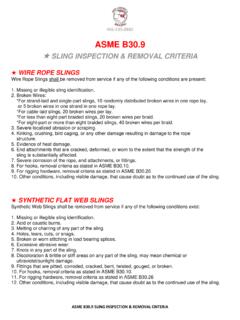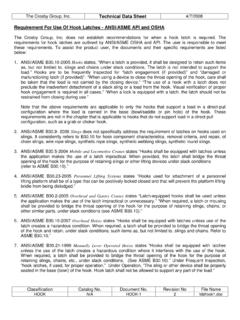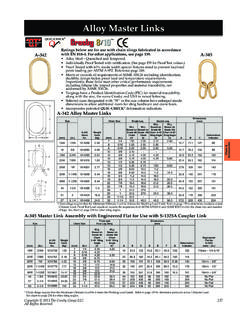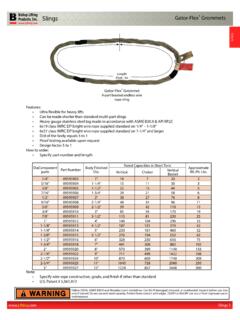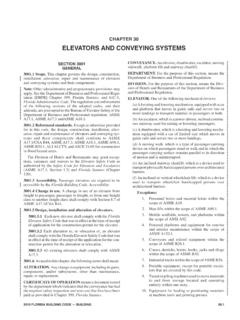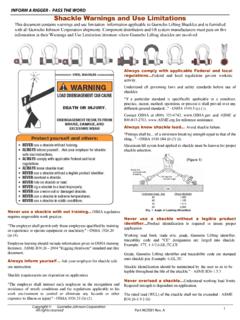Transcription of The rated capacity of a sling and what it means to …
1 The rated capacity of a sling varies depending upon the type of sling , the size of the sling , and the type of hitch. The american society of mechanical Engineers (ASME) requires that all wire rope slings be tagged with the name or trademark of the manufacturer, the rated capacity for speci c con gura-tions and the diameter or size of the sling . Under no circumstances shall a sling s rated capacity be exceeded. The user should maintain this identi- cation so that it is legible during the life of the sling . All persons using the sling should read the tag and understand the information on rated capacity of a wire rope sling is based upon the Minimum Breaking Force (MBF) of the wire rope used in the sling and other 2 Union A WireCo WorldGroup Br andD/d RATIOSWhen a sling is rigged as a basket, the diameter of the bend where the sling contacts the load can affect the sling s lifting capacity .
2 How much the lifting capacity is affected can be calculated by dividing the diameter of the bend where the rope contacts the load(represented by D ) by the diameter of the rope or the component rope diameter in a multi-part sling (represented by d ). For example, if the diameter of the bend ( D ) is 10 and the component rope diameter ( d ) is 1/2, the D/d Ratio is 10 1/2 or , single-part slingsHand-spliced, single-part slingsBraided multi-part slings of 6 partsBraided multi-part slings of 8 partsHelically laid multi-part slingsHand-tucked grommets and mechanically joined grommetsAPPLY STANDARD D/d RATIOS TO DETERMINE EFFICIENCY OF VARIOUS sling CONSTRUCTIONS25 times rope diameter15 times rope diameter25 times component rope diameter25 times component rope diameter25 times component rope diameter5 times sling body diameterWhen D/d ratios smaller than those shown above (or those shown in the footnotes below rated capacity Tables)
3 Are used, the rated capacity of the sling must be rated capacity of a sling and what it means to youfactors that affect the overall strength of the sling , including:> Splicing ef ciency.> Design factor (5 is standard).> Number of parts of rope in the sling .> Type of hitch (straight pull, choker hitch or basket hitch).> Diameter around which the body of the sling is bent (D/d ratio).> Number of legs.> Diameter of the pin (or hook) over which the eye of the sling is rigged. > Angle at which the sling is used.> Hook or other end attachment rated FACTORThe rated capacities for wire rope slings are based on a design factor of 5 per ASME The design factor and other factors are used to calculate the rated capacities.
4 Design factors have been established that allow the sling to give ef cient service to the wire rope slings are usedUnion A WireCo WorldGroup Br and 3 HITCHESHow wire rope slings are con gured to lift a load is called a hitch. Most lifts use one of three basic EYE AND EYE HITCHIf one eye of the sling is attached to the lifting hook and the other eye is attached to the load, this is called a vertical eye and eye, or straight, hitch. A tagline should be used to prevent load rotation that may damage the two or more slings are attached to the same lifting hook, the total hitch becomes, in effect, a lifting bridle and the load is distributed equally among the individual slings .
5 slings used at an angle have a lower rated capacity than one used HITCHIn the choker hitch, one eye of the sling is attached to the lifting hook, while the sling itself is drawn through the other eye. The load is placed inside the choke that is created while the sling is drawn tight over the load through the eye. Choker hitches reduce the lifting capability of a sling since the wire rope component s ability to adjust during the lift is affected. You should only use a choker hitch when the load will not be seriously damaged by the sling body, or the sling damaged by the load, and when the lift requires the sling to hug the load.
6 Never choke a load so that any part of one eye or splice is in the part of the sling that passes through the other eye to form the notes of caution: Always pull a choker hitch tight before the lift is made. It should never be pulled down during the lift. Also, never use only one choker hitch to lift a load that could shift or slide out of the HITCHA basket hitch is formed when both eyes of the sling are placed on the lifting hook, thereby forming a circular basket of the sling . This type of hitch distributes the load equally between the two legs of the sling , within BRIDLESWhen you attach two or more slings to the same lifting hook, or are connected to a link rigged onto the hook, the total hitch becomes a lifting bridle, distrib-uting the load among the individual slings .
7 When using two or more slings as a lifting bridle, remember that the sling angle affects the slings rated capacities. Also, the location of the lift s center of gravity will affect the load on each sling HITCHCHOKER HITCHBASKET HITCHREDUCTION IN EFFICIENCY OF WIRE ROPE WHEN BENT OVER PINS OF VARIOUS SIZES4 Union A WireCo WorldGroup Br andThere are four primary factors to take into consideration when lifting a load. They are: (1) the physical parameters of the load; (2) the number of legs and the angle they make with the horizontal; (3) the rated capacity of the sling ; and (4) the condition of the PARAMETERS OF THE LOADThe size of the object to be lifted, and particularly the location of lifting points, will affect sling selection.
8 The weight of the lift, while a critical component, is only a part of the information. The location of the center of gravity is also necessary to determine sling the load has small diameter corners, protective blocking or softeners must be used so that sling capacity isn t reduced. Also, if lifting a painted object or an object with a nished surface, padding or softeners may be needed between the sling and the load to protect the OF LEGS AND ANGLE WITH THE HORIZONTALAs the angle formed by the sling leg and the hori-zontal decreases, the rated capacity of the sling Sound lifting practicesWhen you re calculating the load of basket hitches and bridles, remember that as the horizontal angle of a sling decreases, the resultant load on each leg increases.
9 The horizontal angle of bridles with three or more legs is measured the same way as hori-zontal sling angles of two-legged hitches. If a bridle is designed with different leg lengths, it may result in different horizontal angles. The load on each leg must be calculated based on the position of the slings and the location of the lift s center of THE rated capacity OF A CHOKER HITCHDue to the body of the sling being used in the choke, there is a reduction in rated capacity . This is re!ected in the choker rated capacity tables. Another reduction that must be considered is due to the angle of the choke (not the angle of the leg of the sling ).
10 If the load is hanging free, the normal choke angle is approximately 135 degrees. When lifting and turning a load using a choker hitch, it is not uncommon to have a severe bend at the choke. When a choker hitch is used at an angle of less than 120 degrees, you must reduce the hitch s rated capacity as shown in the chart at right. You always must adjust the rated capacity of the wire rope sling whenever you use a choker hitch to shift, turn or control a load, or when the pull is against the choke in a multi-leg always, if more than one sling is used and the legs are not vertical, a further reduction in rated capacity must be made for the sling : Choker hitches at angles greater than 135 degrees are not recommended since they are unstable.

